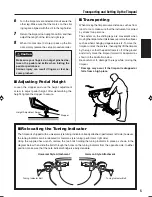
8
When using the timpani for the first time, be sure to set it up according to the
instructions of
“Initial Preparation”
on pages 6 and 7.
When loosening the tuning bolts, always loosen
them by double the desired amount, and then
return (re-tighten) them by half. When the sound
lies within 1 halftone below the desired pitch af-
ter loosening the tuning bolts (repeatedly, if nec-
essary), proceed with step
3
.
3
Lightly strike the head with the mallet about 2
inches (5 cm) from the kettle edge at each tuning
bolt. Check which tuning bolt has the highest
sound.
• Pitch of the highest sound is higher than the
tuning note (*2)
→
Loosen the corresponding tuning bolt by
about 1/16 to 1/18 of a turn. First loosen
the bolt by double the desired amount, and
then return (re-tighten) it by half. After loos-
ening the tuning bolt, repeat from the be-
ginning of step
3
.
• Pitch of the highest sound is lower than the
tuning note
→
Go to step
4
.
4
Tighten the other bolts little by little (by about 1/
16 to 1/8 of a turn) until the sounds at the corre-
sponding striking points match the pitch of the
highest sound. Please note that tightening one
bolt also raises the pitch at neighboring and op-
posite tuning bolts. Thus, after tightening the tun-
ing bolt with the lowest sound, again check the
pitch at the other tuning bolts before tightening
the tuning bolt with the next lowest pitch. While
alternately tightening the other bolts, do not touch
the tuning bolt with the highest pitch (reference
pitch).
Adjusting the Pitch
■
Head Tuning
1
Tuning is adjusted on the lowest note of the tim-
pani. For this reason, the heel of the pedal must
stay fully lowered during the tuning procedure.
The pitch of the lowest note (and the tonal range)
depends on the size of your timpani. For example,
as shown in the chart below, the lowest sound of
a 26" timpani should be tuned to A. When tuned
properly, your Yamaha timpani will play through-
out its full tonal range with balanced tension in
the paddle.
2
Strike the head and check the sound.
The standard striking point is shown below.
■
Standard Tonal Ranges for Yamaha Timpani
The standard striking
point lies at distance B
from the kettle edge,
which corresponds
approximately to 1/4 to
1/3 of the distance
between the kettle
edge and the center of
the head.
• Sound is lower than the tuning note
→
Go to step
3
.
• Sound is higher than the tuning note
→
Loosen the tuning bolts by an equal
amount in the order shown in the figure of
step
5
on page 7.
Striking point
Keep the heel of the pedal fully lowered during
the tuning procedure (steps
2
through
7
below)
if not specified otherwise.
32” (81cm)
29” (74cm)
26” (66cm)
23” (58cm)
tp3100ea_en_om.6pm
08.2.5, 9:28 AM
8

















